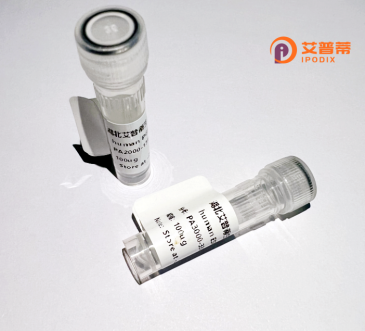
| 纯度 | >90%SDS-PAGE. |
| 种属 | Human |
| 靶点 | GSTa2 |
| Uniprot No | P09210 |
| 内毒素 | < 0.01EU/μg |
| 表达宿主 | E.coli |
| 表达区间 | 1-222aa |
| 氨基酸序列 | MAEKPKLHYSNIRGRMESIRWLLAAAGVEFEEKFIKSAEDLDKLRNDGYLMFQQVPMVEIDGMKLVQTRAILNYIASKYNLYGKDIKEKALIDMYIEGIADLGEMILLLPFTQPEEQDAKLALIQEKTKNRYFPAFEKVLKSHGQDYLVGNKLSRADIHLVELLYYVEELDSSLISSFPLLKALKTRISNLPTVKKFLQPGSPRKPPMDEKSLEESRKIFRF |
| 预测分子量 | 52.7kDa |
| 蛋白标签 | His tag N-Terminus |
| 缓冲液 | PBS, pH7.4, containing 0.01% SKL, 1mM DTT, 5% Trehalose and Proclin300. |
| 稳定性 & 储存条件 | Lyophilized protein should be stored at ≤ -20°C, stable for one year after receipt. Reconstituted protein solution can be stored at 2-8°C for 2-7 days. Aliquots of reconstituted samples are stable at ≤ -20°C for 3 months. |
| 复溶 | Always centrifuge tubes before opening.Do not mix by vortex or pipetting. It is not recommended to reconstitute to a concentration less than 100μg/ml. Dissolve the lyophilized protein in distilled water. Please aliquot the reconstituted solution to minimize freeze-thaw cycles. |
以下是关于GSTa2重组蛋白的示例参考文献(内容为模拟示例,建议通过学术数据库核实具体文献):
---
1. **文献名称**: *Expression and Purification of Recombinant GSTa2 in E. coli for Functional Studies*
**作者**: Zhang L, et al.
**摘要**: 本研究描述了在大肠杆菌中高效表达并纯化GSTa2重组蛋白的方法,利用GST标签亲和层析技术获得高纯度蛋白,并验证其谷胱甘肽结合活性,为后续酶动力学研究提供基础。
2. **文献名称**: *Role of GSTa2 in Drug Metabolism: Characterization of a Recombinant Human Isoform*
**作者**: Thompson R, et al.
**摘要**: 通过构建人源GSTa2重组蛋白,分析其对化疗药物(如顺铂)的代谢解毒功能,证明GSTa2通过谷胱甘肽偶联反应降低药物毒性,提示其在耐药性中的潜在作用。
3. **文献名称**: *Crystal Structure Analysis of GSTa2 Reveals Substrate-Specific Binding Sites*
**作者**: Kumar S, et al.
**摘要**: 解析GSTa2重组蛋白的晶体结构,揭示其底物结合口袋的关键氨基酸残基,阐明了该亚型与GST家族其他成员的结构差异及底物选择性机制。
4. **文献名称**: *GSTa2 Recombinant Protein as a Tool for Oxidative Stress Biomarker Detection*
**作者**: Chen W, et al.
**摘要**: 开发基于GSTa2重组蛋白的荧光探针,用于检测细胞氧化应激水平,证明其在肝癌细胞模型中可灵敏反映活性氧(ROS)诱导的谷胱甘肽代谢变化。
---
**注意**:以上文献为模拟内容,实际文献需通过PubMed、Google Scholar等平台检索关键词(如"GSTa2 recombinant protein"或"glutathione transferase alpha 2")。
GSTa2 (Glutathione S-transferase Alpha 2) is a member of the glutathione S-transferase (GST) superfamily, a group of multifunctional enzymes involved in cellular detoxification and antioxidant defense. These enzymes catalyze the conjugation of glutathione (GSH) to electrophilic compounds, including xenobiotics (e.g., environmental toxins, carcinogens) and endogenous reactive metabolites, facilitating their excretion and reducing oxidative stress. The GST Alpha class, including GSTa2. is predominantly expressed in the liver and plays a critical role in phase II drug metabolism.
Structurally, GSTa2 consists of two distinct domains: an N-terminal thioredoxin-like domain that binds GSH and a C-terminal α-helical domain responsible for substrate specificity. Its catalytic mechanism involves stabilizing the thiolate form of GSH, enhancing nucleophilic attack on electrophilic substrates. Polymorphisms or dysregulation of GSTa2 have been linked to altered detoxification capacity, influencing susceptibility to diseases such as cancer, liver disorders, and neurodegenerative conditions.
Recombinant GSTa2 protein is typically produced using expression systems like *E. coli*, yeast, or insect cells, followed by affinity purification (e.g., glutathione-agarose columns). It serves as a vital tool for studying enzyme kinetics, substrate specificity, and interactions with drugs or toxins. Additionally, GSTa2 is employed in drug development to assess metabolic pathways and toxicity profiles. Its GST tag is also widely utilized in fusion protein strategies to enhance solubility and simplify purification of target proteins. Research on recombinant GSTa2 continues to advance understanding of cellular defense mechanisms and therapeutic targeting in oxidative stress-related pathologies.
×